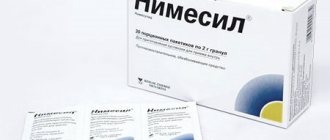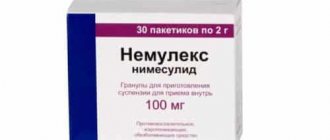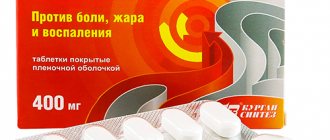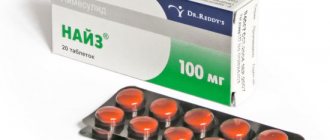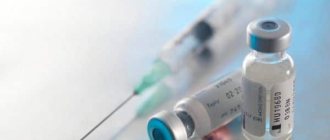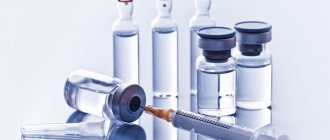Nimesulide
Undesirable side effects can be minimized by using the drug in the minimum effective dose with the minimum duration of use necessary to relieve pain.
There is evidence of very rare cases of serious reactions from the liver, including cases of death, associated with the use of nimesulide-containing drugs. If symptoms similar to signs of liver damage appear (anorexia, itching, yellowing of the skin, nausea, vomiting, abdominal pain, dark urine, increased activity of liver transaminases), you should immediately stop using the drug Nimesulide and consult a doctor. Repeated use of Nimesulide in such patients is contraindicated.
Reactions from the liver, in most cases of a reverse nature, have been reported with short-term use of the drug.
While using the drug Nimesulide, the patient should refrain from taking other analgesics, including NSAIDs (including selective COX-2 inhibitors).
The drug Nimesulide should be used with caution in patients with a history of gastrointestinal diseases (ulcerative colitis, Crohn's disease), since exacerbation of these diseases is possible.
The risk of gastrointestinal bleeding, peptic ulcer/perforation of the stomach or duodenum increases in patients with a history of gastrointestinal ulceration (ulcerative colitis, Crohn's disease), as well as in elderly patients, with an increase in the dose of NSAIDs, so treatment should begin with the lowest possible dose. In such patients, as well as in patients who require the simultaneous use of low doses of acetylsalicylic acid or other drugs that increase the risk of complications from the gastrointestinal tract, it is recommended to additionally prescribe gastroprotectors (misoprostol or proton pump blockers).
Patients with a history of gastrointestinal disease, especially older patients, should report new gastrointestinal symptoms (especially symptoms that may indicate possible gastrointestinal bleeding) to their physician.
Nimesulide should be administered with caution to patients taking drugs that increase the risk of ulceration or bleeding (oral corticosteroids, anticoagulants such as warfarin, selective serotonin reuptake inhibitors or antiplatelet agents such as acetylsalicylic acid).
If gastrointestinal bleeding or gastrointestinal ulceration occurs in patients taking Nimesulide, treatment with the drug must be stopped immediately.
Given reports of visual impairment in patients taking other NSAIDs, if any visual impairment occurs, use of Nimesulide should be immediately discontinued and an ophthalmological examination performed.
The drug may cause fluid retention, therefore, in patients with arterial hypertension, renal and/or heart failure, Nimesulide should be used with extreme caution. If the condition worsens, treatment with Nimesulide should be discontinued.
Clinical studies and epidemiological data suggest that NSAIDs, especially at high doses and with long-term use, may lead to a small risk of myocardial infarction or stroke. There is insufficient data to exclude the risk of such events when using nimesulide.
The drug may cause fluid retention in the body.
Patients with arterial hypertension, renal and/or heart failure, coronary heart disease, peripheral arterial disease and/or cerebrovascular diseases, with risk factors for the development of cardiovascular diseases (for example: hyperlipidemia, in smokers), Nimesulide should be used with caution. . If the condition worsens, treatment with Nimesulide should be discontinued.
If signs of a “cold” or acute respiratory viral infection occur while using the drug Nimesulide, the drug should be discontinued.
Nimesulide can change the properties of platelets, so caution must be exercised when using the drug in people with hemorrhagic diathesis, however, the drug does not replace the preventive effect of acetylsalicylic acid in cardiovascular diseases.
Elderly patients are especially susceptible to adverse reactions to NSAIDs, including the risk of life-threatening gastrointestinal bleeding and perforation, and decreased renal, hepatic, and cardiac function. When taking the drug Nimesulide for this category of patients, proper clinical monitoring is necessary.
There is evidence of rare cases of skin reactions (such as exfoliative dermatitis, Stevens-Johnson syndrome, toxic epidermal necrolysis) when taking NSAIDs, including nimesulide. At the first manifestations of a skin rash, damage to the mucous membranes or other signs of an allergic reaction, Nimesulide should be stopped immediately.
Nimesulide-LF tablets 100 mg No. 10x2
Product description
Nimesulide-lf.
Release forms
Tablets.
INN
Nimesulide.
Description
Round tablets, light yellow in color, with a smooth biconvex surface.
Compound
1 tablet contains: Active substance: nimesulide – 100 mg. Excipients: microcrystalline cellulose, corn starch, sodium starch glycolate, colloidal anhydrous silicon dioxide, talc, magnesium stearate, calcium hydrogen phosphate dihydrate.
Pharmacotherapeutic group
Other nonsteroidal anti-inflammatory antirheumatic drugs. ATX code: M01AX17.
Indications for use
- treatment of acute pain; - primary dysmenorrhea. The drug can only be prescribed as a second-line treatment. The decision to prescribe a drug should be based on an assessment of the overall risk in each individual patient.
Directions for use and doses
In order to minimize unwanted side effects, the minimum effective dose should be taken for the shortest possible course of treatment. The maximum duration of taking nimesulide should not exceed 15 days. For oral administration. Take the tablets with a sufficient amount of water. Adults are prescribed 100 mg (1 tablet) 2 times a day after meals. The maximum daily dose is 200 mg. No dose adjustment of the drug is required in elderly people. Children Children (under 12 years of age): for this category of patients, the prescription of nimesulide-containing medications is contraindicated. Adolescents (12 to 18 years): Based on the pharmacokinetic profile in adults and the pharmacodynamic characteristics of nimesulide, no dose adjustment is necessary in adolescents. Patients with impaired renal function Based on pharmacokinetic data, there is no need for dose adjustment in patients with mild to moderate forms of renal impairment (creatinine clearance 30-80 ml/min), while patients with severe renal impairment (creatinine clearance
Contraindications
- history of hypersensitivity to nimesulide or excipients; - history of hypersensitivity reactions (such as bronchospasm, rhinitis, urticaria) to acetylsalicylic acid or other NSAIDs; - history of hepatotoxic reactions to nimesulide; - stomach or duodenal ulcer, recurrent erosive-ulcerative lesions of the gastrointestinal tract, history of gastrointestinal or cerebral hemorrhage; - previous gastrointestinal bleeding or perforation associated with previous NSAID therapy; - severe disorders of the blood coagulation system; - severe heart failure; - severe renal dysfunction; - liver dysfunction; - children under 12 years of age; - pregnancy; - period of breastfeeding; - simultaneous administration with other potentially hepatotoxic drugs; - alcoholism, drug addiction; - fever and/or flu-like symptoms.
Side effect
Description of the safety profile Based on the results of clinical studies and epidemiological data, the use of some NSAIDs, especially in high doses for a long time, may be accompanied by a slight increase in the risk of pathology caused by arterial thrombosis (for example, myocardial infarction or stroke). Edema, increased blood pressure and heart failure have also been reported during treatment with NSAIDs. When using NSAIDs, there is evidence of very rare cases of bullous reactions, including Stevens-Johnson syndrome and toxic epidermal necrolysis. When treated with NSAIDs, the most common adverse events were gastrointestinal events. Peptic ulcers, perforation or gastrointestinal bleeding may develop, sometimes with fatal consequences, especially in elderly patients. There is information about the appearance of nausea, vomiting, diarrhea, flatulence, constipation, dyspepsia, abdominal pain, tarry stools, vomiting blood, ulcerative stomatitis, exacerbation of colitis and Crohn's disease after taking the drug. Gastritis is less common. The side effects listed below are based on data obtained from controlled clinical studies*. The frequency of adverse reactions listed below was determined using the following notation: very common (> 1/10), common (> 1/100 - 1/1,000 - 1/10,000 -
Overdose
Symptoms of acute NSAID overdose are usually limited to the following: apathy, drowsiness, nausea, vomiting and epigastric pain. With maintenance therapy, these symptoms are usually reversible. Gastrointestinal bleeding may occur. In rare cases, increased blood pressure, acute renal failure, respiratory depression and coma may occur. Anaphylactoid reactions have been reported when taking therapeutic doses of NSAIDs and when overdosing such drugs. In case of NSAID overdose, treatment is symptomatic and supportive. There is no specific antidote. There is no data regarding the elimination of nimesulide by hemodialysis, however, based on the high level of binding to plasma proteins (up to 97.5%), it can be concluded that dialysis is ineffective in case of drug overdose. If there are symptoms of overdose or after taking a large dose of the drug, within 4 hours after administration, patients may be prescribed: inducing vomiting and/or taking activated charcoal (60-100 grams for adults) and/or taking an osmotic laxative. Forced diuresis, urine alkalization, hemodialysis or hemoperfusion may be ineffective due to the high level of binding of nimesulide to blood proteins. Kidney and liver functions should be monitored.
Precautionary measures
Undesirable side effects can be minimized by using the lowest effective dose for the shortest duration necessary to control symptoms of the disease. If there is no improvement in symptoms, drug therapy should be discontinued. In elderly patients, the incidence of adverse reactions to NSAIDs is increased, especially the incidence of gastrointestinal bleeding and perforation (even fatal in some cases), as well as impaired renal, hepatic and cardiac function. Therefore, appropriate clinical observation is recommended. Liver disorders Rare cases of serious liver reactions, including very rare cases of death, have been reported in association with the use of nimesulide-containing medicinal products. Patients experiencing symptoms similar to those of liver damage during treatment with nimesulide (eg, anorexia, nausea, vomiting, abdominal pain, fatigue, dark urine) or patients whose liver function laboratory tests are abnormal, should discontinue drug treatment. Repeated administration of nimesulide is contraindicated in such patients. Liver damage, in most cases reversible, has been reported after short-term exposure to the drug. During treatment with nimesulide, the patient should refrain from taking other analgesics. The concomitant use of nimesulide and other NSAIDs, including selective cyclooxygenase-2 inhibitors, should be avoided. Patients receiving nimesulide who develop flu-like or cold-like symptoms should discontinue treatment with the drug. Gastrointestinal Disorders: Gastrointestinal bleeding, ulceration, and ulcer perforation may be life-threatening if the patient's medical history shows similar problems occurring with any NSAID during treatment (regardless of the time elapsed), with or without the presence of dangerous symptoms, or a history of serious gastrointestinal disorders. The risk of gastrointestinal bleeding, ulceration, or perforation of an ulcer increases with increasing doses of NSAIDs in patients with a history of ulcers, especially those complicated by hemorrhage or perforation, and in elderly patients. For these patients, treatment should be started with the lowest possible dose. For these patients, as well as patients taking concomitant low-dose aspirin or other drugs that increase the risk of gastrointestinal disease, combination therapy with protective agents (eg, misoprostol or proton pump inhibitors) should be considered. Patients with gastrointestinal toxicity, especially the elderly, should report any unusual gastrointestinal symptoms (especially gastrointestinal bleeding). This is especially important in the initial stages of treatment. Gastrointestinal bleeding, as well as the formation of ulcers or perforations, are observed for all NSAIDs at different stages of treatment, regardless of the presence of warning symptoms or a history of gastrointestinal pathology. If gastrointestinal bleeding or ulceration develops, nimesulide should be discontinued. Nimesulide should be administered with caution to patients with gastrointestinal diseases, including peptic ulcers, a history of gastrointestinal bleeding, ulcerative colitis and Crohn's disease. Patients taking concomitant medications that may increase the risk of ulceration or bleeding, such as oral corticosteroids, anticoagulants such as warfarin, selective serotonin reuptake inhibitors, or antiplatelet agents such as aspirin, should be advised to use caution when taking the drug facilities. If gastrointestinal bleeding or ulcers occur in patients receiving nimesulide, treatment with the drug should be discontinued. NSAIDs should be prescribed with caution to patients with a history of gastrointestinal diseases (ulcerative colitis, Crohn's disease), since exacerbation of these diseases is possible. In patients with renal or heart failure, nimesulide should be used with caution as the drug may impair renal function. If the condition worsens, treatment should be discontinued. Skin reactions There have been reports of very rare cases of severe skin reactions to NSAIDs, including exfoliative dermatitis, Stevens-Johnson syndrome and toxic epidermal necrolysis, some of which can be fatal. Patients appear to be at greatest risk of developing skin reactions during the initial period of therapy. Nimesulide should be discontinued at the first signs of skin rash, damage to the mucous membranes and other signs of hypersensitivity. Renal disorders Caution should be exercised when prescribing the drug to patients with impaired renal or cardiac function, since the use of nimesulide may lead to deterioration of renal function. If worsening occurs, treatment should be interrupted. Effect on fertility The use of nimesulide can reduce female fertility, so it is not recommended for women planning pregnancy. In women who have problems conceiving or are undergoing evaluation for infertility, discontinuation of nimesulide should be considered Cardiovascular and cerebrovascular disorders Patients with arterial hypertension and/or a history of mild/moderate acute heart failure, as well as patients with The occurrence of fluid retention in the body and edema, as a reaction to the use of NSAID therapy, requires appropriate monitoring of the condition and consultation with a doctor. Clinical studies and epidemiological data suggest that some NSAIDs, especially at high doses and with long-term use, may lead to a small risk of arterial thrombotic events (eg, myocardial infarction or stroke). There is insufficient data to exclude the risk of such events when using nimesulide. In patients with uncontrolled hypertension, congestive heart failure, established coronary artery disease, peripheral arterial disease and/or cerebrovascular disease, nimesulide should be prescribed after careful evaluation. An equally thorough assessment of the condition should be performed before starting long-term treatment in patients with risk factors for cardiovascular disease (for example, arterial hypertension, hyperlipidemia, diabetes mellitus, smoking). Since nimesulide can affect platelet function, it should be prescribed with caution to patients with bleeding diathesis. However, nimesulide does not replace acetylsalicylic acid in the prevention of cardiovascular diseases.
Use in pediatrics
The use of nimesulide in children under 12 years of age is contraindicated.
Use during pregnancy and lactation
Pregnancy Suppression of prostaglandin synthesis may adversely affect pregnancy and/or fetal development. Data obtained from epidemiological studies suggest that in early pregnancy, the use of drugs that suppress prostaglandin synthesis may increase the risk of spontaneous abortion, fetal heart disease and gastroschisis. The absolute risk of cardiovascular abnormality increased from less than 1% to approximately 1.5%. The risk is believed to increase with increasing dose and duration of use. In animals, administration of a prostaglandin synthesis inhibitor resulted in increased pre- and postimplantation loss and increased embryonic mortality. In addition, evidence was obtained that in animals receiving a prostaglandin synthesis inhibitor during the period of organogenesis, the incidence of various fetal malformations, including the cardiovascular system, increased. You should not take nimesulide during the first and second trimester of pregnancy unless absolutely necessary. When using the drug by women trying to become pregnant, or in the first and second trimester of pregnancy, the lowest possible dose and the shortest possible duration of treatment should be chosen. In the third trimester of pregnancy, all inhibitors of prostaglandin synthesis: 1) can lead to the development in the fetus of: - pneumocardial toxic damage (with premature closure of the arterial ducts and hypertension in the pulmonary artery system); - renal dysfunction, which can progress to renal failure with the development of oligohydramnios; 2) in the mother and fetus at the end of pregnancy it is possible: - an increase in bleeding time, an antiaggregation effect that can occur even when using very low doses of the drug; - suppression of contractile activity of the uterus, which can lead to a delay or prolongation of the period of labor. Therefore, nimesulide is contraindicated in the third trimester of pregnancy. Breastfeeding It is currently unknown whether nimesulide is excreted into breast milk. Nimesulide is contraindicated for use in nursing mothers. Fertility Like other NSAIDs, drugs containing nimesulide are not recommended for use in women planning pregnancy.
Effect on the ability to drive a car or use other machinery
Studies on the effects of nimesulide-containing medicinal products on the ability to drive vehicles and operate machines and mechanisms have not been conducted. Despite this, patients experiencing headache, dizziness or drowsiness after taking nimesulide should not drive a vehicle, machinery or machinery.
Interaction with other drugs
Always tell your doctor what medications you are taking or have recently taken, even if they are over-the-counter medications. Pharmacodynamic interactions Other non-steroidal anti-inflammatory drugs (NSAIDs) The combined use of drugs containing nimesulide and other NSAIDs, including acetylsalicylic acid in anti-inflammatory doses (>1 g as a single dose or >3 g as a total daily dose), is not recommended. Corticosteroids: Increase the risk of gastrointestinal ulcers or bleeding. Anticoagulants: NSAIDs may enhance the effect of anticoagulants such as warfarin or acetylsalicylic acid. Due to the increased risk of bleeding, this combination is not recommended and is contraindicated in patients with severe coagulation disorders. If combination therapy cannot be avoided, careful monitoring of blood clotting parameters is necessary. Antiplatelet agents and selective serotonin reuptake inhibitors (SSRIs): Increase the risk of gastrointestinal bleeding. Diuretics, angiotensin-converting enzyme inhibitors (ACE inhibitors), angiotensin type 2 receptor antagonists (AIIA): NSAIDs may reduce the effectiveness of diuretics and other antihypertensive agents. In some patients with impaired renal function (for example, in dehydrated or elderly patients), co-administration of ACE inhibitors or angiotensin II antagonists, as well as substances that inhibit the cyclooxygenase system, may cause a further decrease in renal function, including acute renal failure. which is usually reversible. This interaction should be taken into account in patients taking nimesulide together with ACE inhibitors or ANAs. Therefore, caution should be exercised when prescribing this combination of drugs, especially in elderly patients. Patients should be kept adequately hydrated and the need to monitor renal function should be considered upon initiation of combination therapy and periodically thereafter. Pharmacokinetic interactions: effects of nimesulide on the pharmacokinetics of other drugs Furosemide: in healthy volunteers, nimesulide temporarily reduced the effect of furosemide on sodium excretion, to a lesser extent on potassium excretion, and reduced the diuretic response. Co-administration of nimesulide and furosemide leads to a decrease (by approximately 20%) in the area under the concentration-time curve (AUC) and a decrease in the cumulative excretion of furosemide without changing the renal clearance of furosemide. Co-administration of furosemide and drugs containing nimesulide requires caution in patients with impaired renal or cardiac function. Lithium: There is evidence that NSAIDs reduce the clearance of lithium, resulting in increased plasma lithium levels and lithium toxicity. When prescribing nimesulide to patients receiving lithium drug therapy, plasma lithium levels should be monitored frequently. In vivo studies were conducted to identify possible pharmacokinetic interactions with glibenclamide, theophylline, warfarin, digoxin, cimetidine and antacid drugs (for example, a combination of aluminum and magnesium hydroxide). No clinically significant interactions were observed. Nimesulide inhibits the activity of the CYP2C9 enzyme. When taking drugs that are substrates of this enzyme with nimesulide, the concentration of these drugs in plasma may increase. When prescribing nimesulide less than 24 hours before or less than 24 hours after taking methotrexate, caution is required, since in such cases the plasma level of methotrexate and, accordingly, the toxic effects of this drug may increase. Due to their effect on renal prostaglandins, inhibitors of prostaglandin synthesis, such as nimesulide, may increase the nephrotoxicity of cyclosporines. Pharmacokinetic interactions: effects of other drugs on the pharmacokinetics of nimesulide In vitro studies have shown that nimesulide is displaced from binding sites by tolbutamide, salicylic acid and valproic acid. Despite the fact that these interactions were determined in blood plasma, these effects were not observed during the clinical use of the drug.
Storage conditions
In a place protected from moisture and light at a temperature not exceeding 25 °C. Keep out of the reach of children.
Best before date
3 years. Do not use after the expiration date stated on the packaging.
Package
10 tablets each in a blister pack made of polyvinyl chloride film and aluminum foil. One or two blister packs along with instructions for medical use in a cardboard pack.
Vacation conditions
On prescription.
Buy Nimesulide-LF tablets 100 mg No. 10x2 in the pharmacy
Price for Nimesulide-LF tablets 100 mg No. 10x2
Instructions for use for Nimesulide-LF tablets 100 mg No. 10x2
